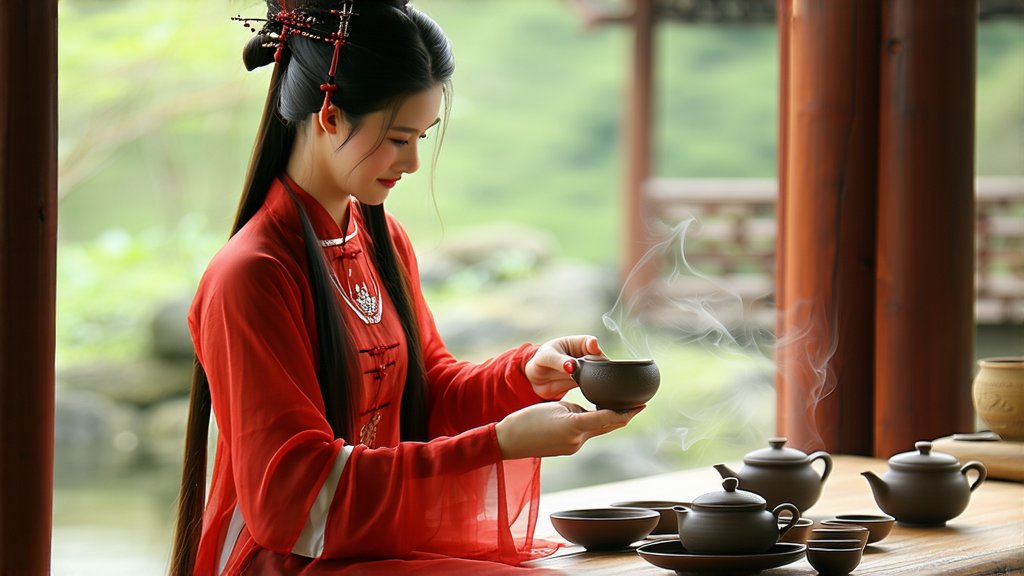
Anhua Black Tea, a gem within the vast spectrum of Chinese black teas, stands as a testament to China's profound tea heritage and its continuous evolution. This unique tea, hailing from the Anhua County in Hunan Province, has not only withstood the test of time but also grown richer in flavor and history, captivating tea aficionados worldwide. As we embark on this exploration, we delve into the historical roots, varieties, meticulous crafting process, and the art of savoring Anhua Black Tea.
Historical Background
The story of Anhua Black Tea dates back to the Tang Dynasty (618-907 AD), when it was initially used as a tribute tea for the imperial court. Its prominence soared during the Ming (1368-1644) and Qing (1644-1912) Dynasties, becoming a favored beverage among Chinese nobility and intellectuals. Unlike other teas that were primarily consumed fresh, Anhua Black Tea underwent a unique post-fermentation process, allowing it to age gracefully over time, enhancing its complexity and depth. This aging process, akin to fine wine or whiskey maturation, sets Anhua Black Tea apart, making it a living artifact of Chinese cultural ingenuity.
Varieties and Classification
Anhua Black Tea encompasses several distinct categories, each with its own character and charm. Among them, "Chen" (aged) brick tea is perhaps the most renowned. These bricks are compressed forms of tea leaves, often wrapped in bamboo leaves or paper, facilitating long-term storage and slow fermentation. Other notable variations include "Thousand Two Tea," known for its intricate processing involving over a thousand steps, and "Fu Brick Tea," which incorporates additional herbal ingredients for health benefits. Each variety offers a glimpse into the region's diverse tea-making traditions and the adaptability of Anhua Black Tea to different palates.
The Art of Crafting Anhua Black Tea
The journey from leaf to cup for Anhua Black Tea is an intricate dance between nature and human skill. Harvested from ancient tea trees, the leaves undergo a series of meticulous steps: withering under the sun to reduce moisture content, rolling to release juices and initiate oxidation, and then steaming to halt oxidation and fix the tea's color. Following this, the leaves are pile-fermented, a process where microorganisms interact with the tea, imparting earthy undertones and deepening flavors. Finally, the tea may be compressed into various shapes like bricks, cakes, or bowls before being left to age, developing a rich, mellow taste over years or even decades.
Tasting the Essence of Anhua Black Tea
To truly appreciate Anhua Black Tea, one must engage in the ritual of tea tasting, or "Gongfu Cha." Begin by selecting a high-quality aged tea, preferably a well-matured Chen brick. Break off a small piece and rinse it briefly with boiling water to awaken its flavors. Next, steep the tea in a Yixing clay teapot or a Gaiwan, using water just off the boil. The first infusion serves as a prelude, cleansing the leaves and preparing them for subsequent steepings. Subsequent infusions will reveal layers of complexity—earthy notes reminiscent of forest floors, subtle sweetness hinting at dried fruits, and a lingering aftertaste that speaks of time's gentle touch on the tea. Pay attention to the tea's aroma, color, mouthfeel, and the evolving flavors with each sip.
In conclusion, Anhua Black Tea is more than just a beverage; it is a cultural embodiment of China's enduring relationship with tea. From its storied past to the careful craftsmanship involved in its production, and the meditative practice of its consumption, every aspect of Anhua Black Tea invites us to slow down and savor life's simple pleasures. As you raise your cup, let it serve as a bridge connecting you to centuries of tradition and the hands that have lovingly shaped this remarkable tea.